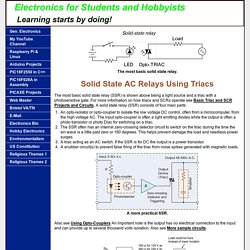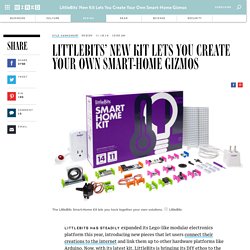Zoom
Trash

Open Source Control Software Round-up : homeautomation. Find the Right Linux-Friendly Single Board Computer with This List. A New Gadget That Lets You Invent Your Own Internet of Things. Thingsee One is an open source, Internet of Things gadget packed with sensors for light and pressure, plus an accelerometer, gyroscope, and magnetometer.

Haltian Using the app, users can program what data they want to record, and where the device is located---all with the aim of making it into a versatile sensor platform for IoT applications. Created by a team of ex-Nokians in Finland, Thingsee is designed to be open source, for either gadget enthusiasts to play with, or for developers entering the connected gadget app space. Thingsee collects tons of sensory data on its environment, and the battery lasts up to a year. So once it's in a fixed environment, users can keep tabs on that place to learn more about it. It’s a familiar adage in the tech world that hardware is hard.
This is why Ville Ylläsjärvi thinks Thingsee One, the open source, Internet of Things gadget his company is Kickstarting, will have staying power. Longer Battery Life Is Key. A New Gadget That Lets You Invent Your Own Internet of Things. A moment of brilliance? UPnP for Internet of Stuff lightbulbs. Reducing the cost and complexity of web vulnerability management Breaking Fad Home automation can be a lot of fun.

However, it can also be the cause of an awful lot of headaches. So, you thought those remote control plug sockets from the DIY store were a good deal? Shedding light on compatibility issues Maybe they were ... and then you find, when you get them home, that they use a different protocol to the fancy new thermostat you bought. Like many people who've dabbled in this sort of thing, I have different bits of kit bought at different times to solve specific problems. Typically it's past its prime, as I found when I tried to persuade my very old Z-Wave sockets to work with the Raspberry Pi-based n-Cube that was looking after a thermostat and radiator valves. It sometimes seems that the only way to make sure that everything is going to work the way you want is going to be by buying it all at the same time, and planning it properly before you start.
iBeacon Alternative: Arduino Beacons and Evothings HTML Studio. Want to create your own beacon?
Grab an Arduino and check out the Evothings road map to make it happen. The company demonstrates how to use their Evothings Studio to deliver interactions based on HTML and Javascript to to the end user, whether for iOS or Android. Using a relaxation/exercise example, the company notes that by creating your own beacon from widely-available Arduino components, you can overcome limitations with the Apple iBeacon specification.
They make a strong argument for the approach:
Tips for Designing a Connected Home That Isn't Chaos. Giordano Poloni/Getty Not much is certain in technology and design, except for one pattern we’ve seen time and again: whenever a new class of technology becomes available, everyone wants a piece of it.

In the late ’90s it was websites, then it was apps, and now it’s connected everything, aka, the Internet of Things (IoT). But there’s a problem for companies trying to make the most of this new market: people don’t aspire to have connected homes; we all just want to have a better life at home. As designers who think a lot about the problems and potentials of the connected home, we have some suggestions for connected-home companies. Anticipate How Wrong a Design Could Go Poorly designed products have always had difficulty sticking around for the long haul, and they usually leave little impact when they disappear from the landscape.
For example, let’s say you have your kitchen redone one year from now. John Kiechel and Louisa Heinrich And this isn’t even the only problem. Solid State AC Relays Using Triacs. The most basic solid state relay.

The most basic solid state relay (SSR) is shown above being a light source and a triac with a photosensitive gate. For more information on how triacs and SCRs operate see Basic Triac and SCR Projects and Circuits. A solid state relay (SSR) consists of four main parts: An opto-isolator or opto-coupler to isolate the low voltage DC control, often from a microcomputer, from the high voltage AC.
The input opto-coupler is often a light emitting diodes while the output is often a photo transistor or photo Diac for switching on a triac.The SSR often has an internal zero-crossing detector circuit to switch on the triac during the time the sin wave is a little past zero or 180 degrees. A more practical SSR. Also see Using Opto-Couplers An important note is the output has no electrical connection to the input and can provide up to several thousand volts isolation.
Relay_circuit_schematic_L.jpg (JPEG Image, 1808 × 1275 pixels) - Scaled (56%) Controle TRIAC com Arduino (Dimmer) A Real-World Button for Controlling Your Favorite Apps. As anyone who’s fumbled with an idiotic touchscreen interface in a car will know, sometimes a good old button is the best way to get something done.

Flic takes that thinking and applies it to, well, pretty much anything you want. Flic is a small rubber button about the size of a quarter. Using an app, you can assign it to a number of functions, and, eventually, its inventors hope, link it to other apps and services. If you’ve got a smart home setup going, you can use it to dim the lights and launch Netflix with one touch. If you’re jogging at night, you can use it as a panic button, configuring it to send your location and a distress signal to a friend in the event of trouble. The Best UI of All Joacim Westlund, co-founder of the Swedish startup Shortcut Labs, came up with the idea while trying to kick his tobacco habit. LittleBits' New Kit Lets You Create Your Own Smart-Home Gizmos. LittleBits has steadily expanded its Lego-like modular electronics platform this year, introducing new pieces that let users connect their creations to the internet and link them up to other hardware platforms like Arduino.

Now, with its latest kit, LittleBits is bringing its DIY ethos to the smart home. The company’s Smart Home Kit is meant to let people build their own version of the internet of things. With six new pieces, users can hack together versions of familiar smart-home concepts—connected coffee pots and presence-aware lamps—or create solutions of their own devising. The idea, says LittleBits CEO Ayah Bdeir, is to give people an alternative to the prepackage solutions being “parachuted” into homes by companies like Belkin and Cisco.
Which Ideas Are Worth Your Time—And Money? At $249, it’s one of the company’s biggest kits to date.